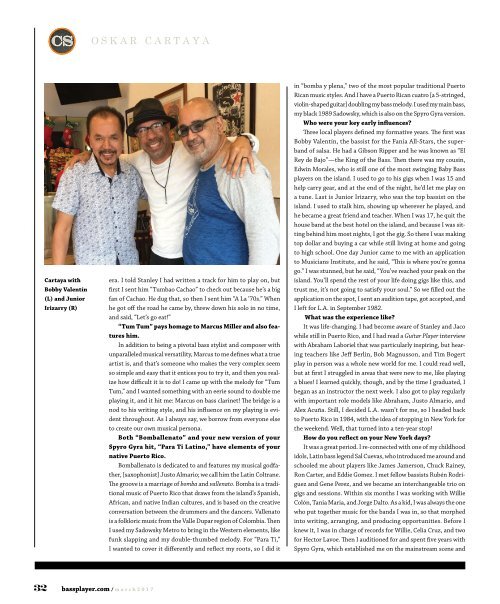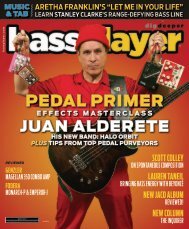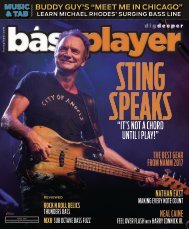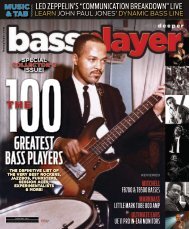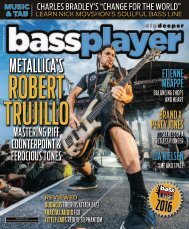BassPlayer 2017-03
BassPlayer 2017-03
BassPlayer 2017-03
Create successful ePaper yourself
Turn your PDF publications into a flip-book with our unique Google optimized e-Paper software.
CS<br />
Oskar Cartaya<br />
Cartaya with<br />
Bobby Valentín<br />
(L) and Junior<br />
Irizarry (R)<br />
era. I told Stanley I had written a track for him to play on, but<br />
first I sent him “Tumbao Cachao” to check out because he’s a big<br />
fan of Cachao. He dug that, so then I sent him “A La ’70s.” When<br />
he got off the road he came by, threw down his solo in no time,<br />
and said, “Let’s go eat!”<br />
“Tum Tum” pays homage to Marcus Miller and also features<br />
him.<br />
In addition to being a pivotal bass stylist and composer with<br />
unparalleled musical versatility, Marcus to me defines what a true<br />
artist is, and that’s someone who makes the very complex seem<br />
so simple and easy that it entices you to try it, and then you realize<br />
how difficult it is to do! I came up with the melody for “Tum<br />
Tum,” and I wanted something with an eerie sound to double me<br />
playing it, and it hit me: Marcus on bass clarinet! The bridge is a<br />
nod to his writing style, and his influence on my playing is evident<br />
throughout. As I always say, we borrow from everyone else<br />
to create our own musical persona.<br />
Both “Bomballenato” and your new version of your<br />
Spyro Gyra hit, “Para Ti Latino,” have elements of your<br />
native Puerto Rico.<br />
Bomballenato is dedicated to and features my musical godfather,<br />
[saxophonist] Justo Almario; we call him the Latin Coltrane.<br />
The groove is a marriage of bomba and vallenato. Bomba is a traditional<br />
music of Puerto Rico that draws from the island’s Spanish,<br />
African, and native Indian cultures, and is based on the creative<br />
conversation between the drummers and the dancers. Vallenato<br />
is a folkloric music from the Valle Dupar region of Colombia. Then<br />
I used my Sadowsky Metro to bring in the Western elements, like<br />
funk slapping and my double-thumbed melody. For “Para Ti,”<br />
I wanted to cover it differently and reflect my roots, so I did it<br />
in “bomba y plena,” two of the most popular traditional Puerto<br />
Rican music styles. And I have a Puerto Rican cuatro [a 5-stringed,<br />
violin-shaped guitar] doubling my bass melody. I used my main bass,<br />
my black 1989 Sadowsky, which is also on the Spyro Gyra version.<br />
Who were your key early influences?<br />
Three local players defined my formative years. The first was<br />
Bobby Valentín, the bassist for the Fania All-Stars, the superband<br />
of salsa. He had a Gibson Ripper and he was known as “El<br />
Rey de Bajo”—the King of the Bass. Then there was my cousin,<br />
Edwin Morales, who is still one of the most swinging Baby Bass<br />
players on the island. I used to go to his gigs when I was 15 and<br />
help carry gear, and at the end of the night, he’d let me play on<br />
a tune. Last is Junior Irizarry, who was the top bassist on the<br />
island. I used to stalk him, showing up wherever he played, and<br />
he became a great friend and teacher. When I was 17, he quit the<br />
house band at the best hotel on the island, and because I was sitting<br />
behind him most nights, I got the gig. So there I was making<br />
top dollar and buying a car while still living at home and going<br />
to high school. One day Junior came to me with an application<br />
to Musicians Institute, and he said, “This is where you’re gonna<br />
go.” I was stunned, but he said, “You’ve reached your peak on the<br />
island. You’ll spend the rest of your life doing gigs like this, and<br />
trust me, it’s not going to satisfy your soul.” So we filled out the<br />
application on the spot, I sent an audition tape, got accepted, and<br />
I left for L.A. in September 1982.<br />
What was the experience like?<br />
It was life-changing. I had become aware of Stanley and Jaco<br />
while still in Puerto Rico, and I had read a Guitar Player interview<br />
with Abraham Laboriel that was particularly inspiring, but hearing<br />
teachers like Jeff Berlin, Bob Magnusson, and Tim Bogert<br />
play in person was a whole new world for me. I could read well,<br />
but at first I struggled in areas that were new to me, like playing<br />
a blues! I learned quickly, though, and by the time I graduated, I<br />
began as an instructor the next week. I also got to play regularly<br />
with important role models like Abraham, Justo Almario, and<br />
Alex Acuña. Still, I decided L.A. wasn’t for me, so I headed back<br />
to Puerto Rico in 1984, with the idea of stopping in New York for<br />
the weekend. Well, that turned into a ten-year stop!<br />
How do you reflect on your New York days?<br />
It was a great period. I re-connected with one of my childhood<br />
idols, Latin bass legend Sal Cuevas, who introduced me around and<br />
schooled me about players like James Jamerson, Chuck Rainey,<br />
Ron Carter, and Eddie Gomez. I met fellow bassists Rubén Rodríguez<br />
and Gene Perez, and we became an interchangeable trio on<br />
gigs and sessions. Within six months I was working with Willie<br />
Colón, Tania Maria, and Jorge Dalto. As a kid, I was always the one<br />
who put together music for the bands I was in, so that morphed<br />
into writing, arranging, and producing opportunities. Before I<br />
knew it, I was in charge of records for Willie, Celia Cruz, and two<br />
for Hector Lavoe. Then I auditioned for and spent five years with<br />
Spyro Gyra, which established me on the mainstream scene and<br />
32 bassplayer.com / march<strong>2017</strong>


